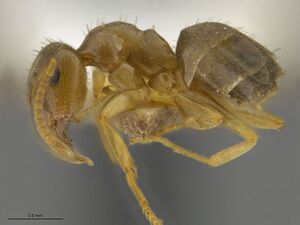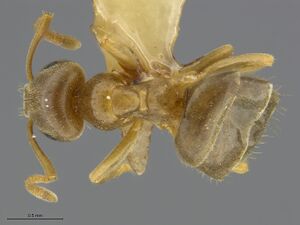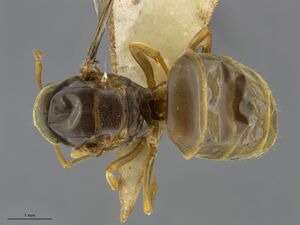Lasius sitiens
| Lasius sitiens | |
|---|---|

| |
| Scientific classification | |
| Kingdom: | Animalia |
| Phylum: | Arthropoda |
| Class: | Insecta |
| Order: | Hymenoptera |
| Family: | Formicidae |
| Subfamily: | Formicinae |
| Tribe: | Lasiini |
| Genus: | Lasius |
| Section: | niger clade |
| Species group: | niger |
| Species: | L. sitiens |
| Binomial name | |
| Lasius sitiens Wilson, 1955 | |
Identification
Mackay and Mackay (2002) - This species can be recognized by the lack of erect hairs on the scapes (there are numerous appressed hairs, and erect hairs at the apex), the medium sized eyes with about 11 ommatidia in greatest diameter, and the yellowish-brown color. The tibiae are also without erect hairs (appressed hairs present).
Navajo Nature - A small, light-colored species with small eyes. Color typically medium yellowish brown, rarely dark yellowish brown. The scapes of the workers have hairs that are entirely decumbent, which separates this species from the somewhat similar co-occuring Lasius fallax. The latter has dense standing pubescence on its scapes.
Key to Lasius workers, queens, males
Keys including this Species
- Key to Lasius Nearctic workers with long maxillary palpi
- Key to Lasius males
- Key to Lasius queens
- Key to North American Lasius Species
Distribution
Southwestern United States and northern Mexico.
Latitudinal Distribution Pattern
Latitudinal Range: 52.02713889° to 19.33317°.
| North Temperate |
North Subtropical |
Tropical | South Subtropical |
South Temperate |
- Source: AntMaps
Distribution based on Regional Taxon Lists
Nearctic Region: United States (type locality).
Neotropical Region: Mexico.
Distribution based on AntMaps
Distribution based on AntWeb specimens
Check data from AntWeb
Countries Occupied
| Number of countries occupied by this species based on AntWiki Regional Taxon Lists. In general, fewer countries occupied indicates a narrower range, while more countries indicates a more widespread species. |

|
Biology
Wilson (1955) - This species is limited to the lower altitudinal forest belts in the mountains of the Southwest, from juniper scrub at 7000 feet or less to mixed pine-spruce at 8000 feet. Judging from ecological notes accumulated by W. M. Wheeler, Cole, and myself, it nests almost exclusively under stones in dry, open situations. The type locality is situated in an area of open juniper scrub and scattered bunch-grass. Lasisus sitiens is co-dominant at this spot with several species of Myrmecocystus, Pogonomyrmex and Conomyrma. At the base of the San Francisco Peaks, near Flagstaff, I found sitiens again abundant, nesting under rocks in open pine forest. In New Mexico Cole has taken sitiens primarily in pine forest and clearings bounded by pine forest. The ecological extremes in which he collected this species are as follows: near Los Alamos, a nest in an open, grassy area with scattered pine and juniper at 6400 feet; near Taos, a nest in moist pine-spruce woods at 8000 feet.
The light coloration, small eyes, and shortened appendages of sitiens constitute a remarkable morphological convergence to the species of the subgenus Cautolasius, and specifically to the primitive species Lasius alienoflavus. There can be little question that the characters shared by these two species are the mark of a subterranean mode of life. At the type locality I was unable to find any workers foraging above ground either during the day or in the early night; in contrast, wherever the related species neoniger occurs its workers can nearly always be found above ground at any time of the day or night.
No nuptial flights of sitiens have been recorded. Reproductives have been taken in nido on six occasions, from July 2 (Campbell Blue Creek, Apache Nat. For., Ariz.) to July 30 (Bandelier Nat. Mon., N. Mex.). This would seem to indicate an early reproductive period similar to that of Lasius crypticus.
In New Mexico (Mackay and Mackay 2002) – Occurs in residential areas, disturbed sites, grasslands, juniper, pinyon-juniper, ponderosa pine, aspen-spruce forest. This is a common species, which nests under stones in sandy soils, loam and rocky soils. One nest was in a rotten log. Brood was present in nests from March to August, reproductives were captured in nests from late June to early August. This species occasionally nests together with other Lasius, Formica argentea, and Formica occulta, as well as with Monomorium minimum, Camponotus and Solenopsis molesta. In other instances, this species was nesting together under a rock with Crematogaster punctulata, Solenopsis molesta, Formica argentea, and Monomorium minimum, in a second case, with Formica occulta, Lasius latipes and Myrmica hamulata. It is the host of the cricket Myrmecophila sp.
Castes
- Worker
   
| |
| . | Owned by Museum of Comparative Zoology. |
- Queen
   
| |
| . | Owned by Museum of Comparative Zoology. |
Nomenclature
The following information is derived from Barry Bolton's Online Catalogue of the Ants of the World.
- sitiens. Lasius (Lasius) sitiens Wilson, 1955a: 108 (w.q.m.) U.S.A.
Unless otherwise noted the text for the remainder of this section is reported from the publication that includes the original description.
Description
Worker
(1) The outstanding diagnostic character is the small eye size: maximum eye length (EL) only 0.21-0.25 X the HW, whereas it always exceeds 0.25 X the HW in Lasius neoniger and Lasius crypticus and members of the niger complex. The maximum ommatidium number in a line along the long axis of the eye is typically 11 in sitiens, and occasionally 10 or 12; in related species it is typically 14 or 15 and occasionally 13 or 16.
(2) Averaging smaller than other members of the subgenus; PW rarely exceeding 0.56 mm. and usually less than 0.54 mm.
(3) Scapes and tibiae lacking standing hairs.
(4) Color typically medium yellowish brown, rarely dark yellowish brown.
PW maximum range 0.40-0.56 mm. In a sample of 53 from as many nest series, mean with standard error 0.472 ± 0.006 mm., standard deviation 0.042 mm. Appendages noticeably shorter than in related species. Scape index low, falling along the extrapolated Lasius brunneus SI-HW regression zone, but overlapping the lower extremity of the Lasius crypticus zone. The funiculus is also shortened, to the extent that flagellar segments I and II are as broad as long or slightly (never more than 1.3 X) broader than long, and segment III is as broad as long to slightly longer than broad; most of the range of this variation may be seen in single nest series. Maxillary palp segments V and VI subequal, quite short with respect to total body size, so that their length varies between 0.5 X and 0.8 X the maximum fore-tibia width. The head shape is slightly divergent from that of other species in that the largest workers show a ,'mature" allometric broadening of the head just behind the eyes; i.e. the allometric variation in head shape seen in larger species is expressed on a more diminutive scale in this species. Scapes and fore tibiae ordinarily devoid of hairs of any sort, although several decumbent to sub decumbent hairs were observed on the scapes in a single series from Sapello Canyon, New Mexico.
Queen
Very similar to the queen of crypticus, differing only in the following two characters.
(1) Averaging and ranging smaller; HW range in all available series 0.63-0.78 mm.
(2) Body medium to dark brown, with pale yellowish brown legs.
Male
In this caste the anterior border of the median lobe of the clypeus is broadly rounded, in contradistinction to the angular condition of the worker and queen of the same species, and males of neoniger and crypticus. Individuals are therefore not surely separable from small, faded alienus males. The following two characters represent distinctive trends but are not absolutely diagnostic.
(1) Averaging and ranging smaller than other members of the subgenus; HW range in all available series 0.63-0.78 mm.
(2) Body medium to dark brown, with pale yellowish brown legs.
Type Material
HOLOTYPE. A worker in the Museum of Comparative Zoology, selected from a nest series collected 20 miles north of Flagstaff, Arizona, on U. S. Route 89, July 25,1952, with associated winged queens and males (E. O. Wilson leg.). Paranidotypes in MCZ, National Museum of Natural History, and Creighton Coll.
References
- Alatorre-Bracamontes, C.E., Vásquez-Bolaños, M. 2010. Lista comentada de las hormigas (Hymenoptera: Formicidae) del norte de México. Dugesiana 17(1): 9-36.
- Mackay, W. P. and E. Mackay. 2002. The ants of New Mexico (Hymenoptera: Formicidae). Edwin Mellen Press, Lewiston, NY.
- Wilson, E. O. 1955a. A monographic revision of the ant genus Lasius. Bulletin of the Museum of Comparative Zoology 113: 1-201 (page 108, worker, queen, male described)
References based on Global Ant Biodiversity Informatics
- Allred D. M. 1982. Ants of Utah. The Great Basin Naturalist 42: 415-511.
- Allred, D.M. 1982. The ants of Utah. Great Basin Naturalist 42:415-511.
- Bestelmeyer B. T., and J. A. Wiens. 2001. Local and regional-scale responses of ant diversity to a semiarid biome transition. Ecography 24: 381-392.
- Cokendolpher J. C., and O. F. Francke. 1990. The ants (Hymenoptera, Formicidae) of western Texas. Part II. Subfamilies Ecitoninae, Ponerinae, Pseudomyrmecinae, Dolichoderinae, and Formicinae. Special Publications, the Museum. Texas Tech University 30:1-76.
- Cover S. P., and R. A. Johnson. 20011. Checklist of Arizona Ants. Downloaded on January 7th at http://www.asu.edu/clas/sirgtools/AZants-2011%20updatev2.pdf
- Dattilo W. et al. 2019. MEXICO ANTS: incidence and abundance along the Nearctic-Neotropical interface. Ecology https://doi.org/10.1002/ecy.2944
- Fernandes, P.R. XXXX. Los hormigas del suelo en Mexico: Diversidad, distribucion e importancia (Hymenoptera: Formicidae).
- Johnson R. Personnal Database. Accessed on February 5th 2014 at http://www.asu.edu/clas/sirgtools/resources.htm
- La Rivers I. 1968. A first listing of the ants of Nevada. Biological Society of Nevada, Occasional Papers 17: 1-12.
- Longino, J.T. 2010. Personal Communication. Longino Collection Database
- MacKay W. P. 1993. Succession of ant species (Hymenoptera: Formicidae) on low-level nuclear waste sites in northern New Mexico. Sociobiology 23: 1-11.
- Mackay W. P., and E. E. Mackay. 2002. The ants of New Mexico (Hymenoptera: Formicidae). Lewiston, New York: Edwin Mellen Press, 400 pp.
- Mackay, W., D. Lowrie, A. Fisher, E. Mackay, F. Barnes and D. Lowrie. 1988. The ants of Los Alamos County, New Mexico (Hymenoptera: Formicidae). pages 79-131 in J.C. Trager, editor, Advances in Myrmecololgy.
- MontBlanc E. M., J. C. Chambers, and P. F. Brussard. 2007. Variation in ant populations with elevation, tree cover, and fire in a Pinyon-Juniper-dominated watershed. Western North American Naturalist 67(4): 469491.
- Nielsen, M.G. 1986. Respiratory rates of ants from different climatic areas. Journal of Insect Physiology 32(2): 125-131
- O'Keefe S. T., J. L. Cook, T. Dudek, D. F. Wunneburger, M. D. Guzman, R. N. Coulson, and S. B. Vinson. 2000. The Distribution of Texas Ants. The Southwestern Entomologist 22: 1-92.
- Van Pelt, A. 1983. Ants of the Chisos Mountains, Texas (Hymenoptera: Formicidae) . Southwestern Naturalist 28:137-142.
- Vásquez-Bolaños M. 2011. Lista de especies de hormigas (Hymenoptera: Formicidae) para México. Dugesiana 18: 95-133
- Wheeler G. C., and J. Wheeler. 1986. The ants of Nevada. Los Angeles: Natural History Museum of Los Angeles County, vii + 138 pp.
- Wheeler G. C., and J. Wheeler. 1987. A Checklist of the Ants of South Dakota. Prairie Nat. 19(3): 199-208.
- Wheeler, G.C. and J. Wheeler. 1988. A checklist of the ants of Montana. Psyche 95:101-114
- Wheeler, G.C. and J. Wheeler. 1988. A checklist of the ants of Wyoming. Insecta Mundi 2(3&4):230-239
- Wilson E. O. 1955. A monographic revision of the ant genus Lasius. Bulletin of the Museum of Comparative Zoology 113: 1-201
- Pages using DynamicPageList3 parser function
- North temperate
- North subtropical
- Tropical
- Ant Associate
- Host of Crematogaster punctulata
- Host of Solenopsis molesta
- Host of Formica argentea
- Host of Monomorium minimum
- Host of Formica occulta
- Host of Lasius latipes
- Host of Myrmica hamulata
- Species
- Extant species
- Formicidae
- Formicinae
- Lasiini
- Lasius
- Lasius sitiens
- Formicinae species
- Lasiini species
- Lasius species
- Need Overview
- Need Body Text

